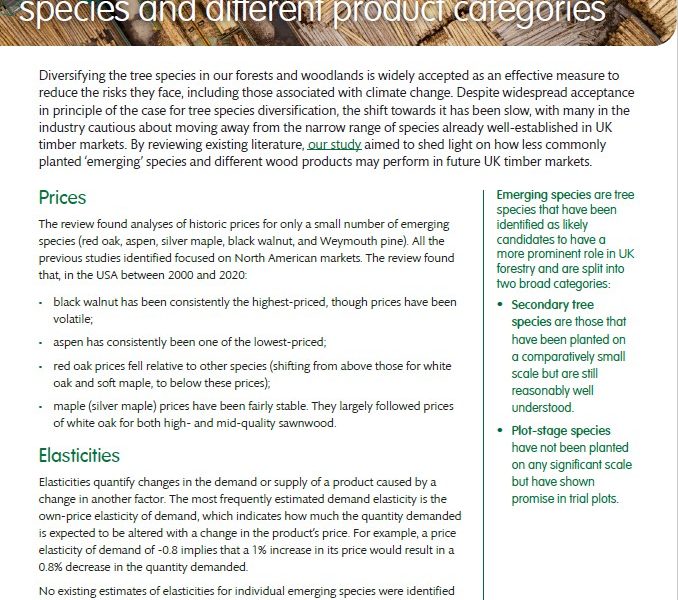We use some essential cookies to make this website work.
We’d like to set additional cookies to understand how you use forestresearch.gov.uk, remember your settings and improve our services.
We also use cookies set by other sites to help us deliver content from their services.

Overview This In Brief summarises a report on future timber prices and price elasticities of demand for emerging species and different product categories. The report reviewed existing studies, focusing on those most relevant to UK timber markets. The emerging species considered are those tree species predicted to have a more...
A new generation of British grown Douglas fir trees has been selected after decades of research, following a project led by Forest Research and the Conifer Breeding Cooperative.
It is within the remit of Forest Research to produce statistics on a wide range of topics related to forestry. These statistics are made public in the form of reports and datasets that are published periodically and thematically. In order to ascertain when a new iteration of these will be...
Overview This In Brief summarises our recently published Research Report, which explored the issues that matter to cereal farmers in England in relation to trees and tree cover on their farms. The In Brief reports on the general findings of the research, outlines the findings to the research question ‘what...
Overview This Research Report explores the issues that matter to cereal farmers in England in relation to trees and tree cover on their farms. Looking beyond just financial considerations, this report explore which factors guide and shape farmer attitudes to and behaviours regarding trees and tree cover. If we can...
Tom Nisbet, Head of Physical Environmental Sciences, details how the new UKFS Practice Guide supports the creation and management of riparian woodlands to protect waterways and enhance biodiversity.
Overview The overall aim of the review is to explore whether there is sufficient evidence to understand relationships between these forest types and their associated biodiversity and to identify gaps in understanding. Such a review is particularly needed at this time of significant declines in biodiversity and associated regulating and...
Two new videos by Forest Research have been released to help build awareness of drought risk amongst landowners and land managers.
Overview This publication summarises a study into the main physical and mechanical properties of eight lesser planted forestry species in the UK: European silver fir, Pacific silver fir, grand fir, Caucasian fir, Serbian spruce, Japanese red cedar, sycamore and silver birch. There is currently limited information available on their wood...
Detection dogs have been used in the UK to successfully identify tree disease, helping track down the deadly tree pathogen Phytophthora ramorum.
This tree species guide, developed in partnership with the University of Reading following a rapid review of literature, databases, and stakeholder consultation, provides a user-friendly overview of the physical characteristics, environmental tolerances, silvicultural traits, and ecosystem services and disservices of 33 tree and shrub species suitable for UK agroforestry systems.
Cookies are files saved on your phone, tablet or computer when you visit a website.
We use cookies to store information about how you use the dwi.gov.uk website, such as the pages you visit.
Find out more about cookies on forestresearch.gov.uk
We use 3 types of cookie. You can choose which cookies you're happy for us to use.
These essential cookies do things like remember your progress through a form. They always need to be on.
We use Google Analytics to measure how you use the website so we can improve it based on user needs. Google Analytics sets cookies that store anonymised information about: how you got to the site the pages you visit on forestresearch.gov.uk and how long you spend on each page what you click on while you're visiting the site
Some forestresearch.gov.uk pages may contain content from other sites, like YouTube or Flickr, which may set their own cookies. These sites are sometimes called ‘third party’ services. This tells us how many people are seeing the content and whether it’s useful.